Business Finance: Ratios, Performance, and Limitations
VerifiedAdded on 2023/01/09
|6
|1291
|56
Report
AI Summary
This report provides an in-depth analysis of business finance, focusing on the significance of various financial ratios as indicators of company performance. It explores key ratios such as Gross Profit Margin, Net Profit Margin, Return on Capital Employed (ROCE), Current Ratio, Acid Test Ratio, and Gearing, explaining their importance in assessing a company's financial health and efficiency. The report also addresses the limitations of using financial ratios, highlighting factors such as reliance on past performance, accounting changes, operational modifications, potential data manipulation by management, and the inability of ratio analysis to capture all aspects of a business's dynamics. The conclusion emphasizes the value of ratio analysis for identifying cost savings, assessing cash flows, and benchmarking against industry leaders, making it a useful tool for both internal and external stakeholders. The report concludes by summarizing the main findings and their implications for business decision-making.

Business Finance
Paraphrase This Document
Need a fresh take? Get an instant paraphrase of this document with our AI Paraphraser
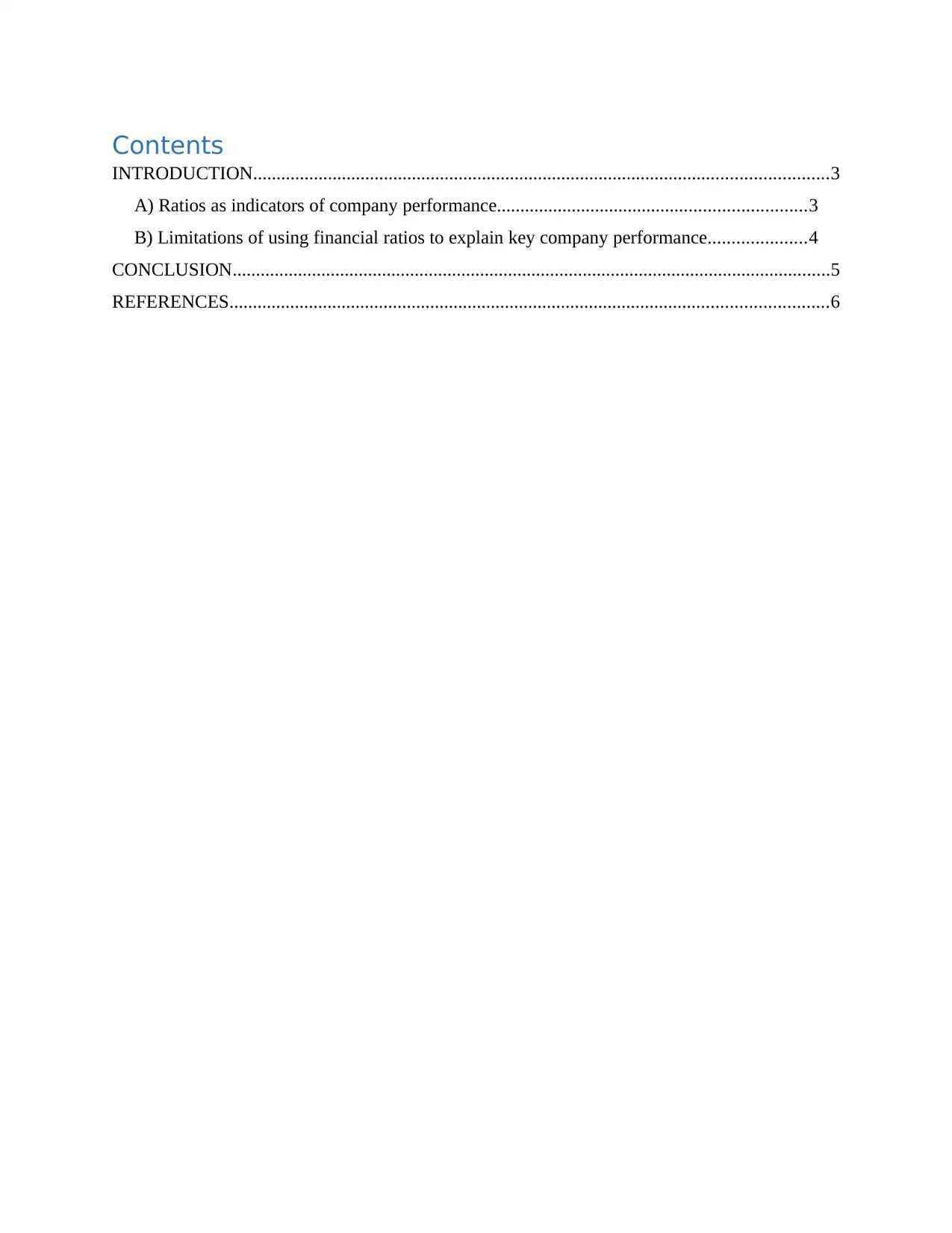
Contents
INTRODUCTION...........................................................................................................................3
A) Ratios as indicators of company performance..................................................................3
B) Limitations of using financial ratios to explain key company performance.....................4
CONCLUSION................................................................................................................................5
REFERENCES................................................................................................................................6
INTRODUCTION...........................................................................................................................3
A) Ratios as indicators of company performance..................................................................3
B) Limitations of using financial ratios to explain key company performance.....................4
CONCLUSION................................................................................................................................5
REFERENCES................................................................................................................................6
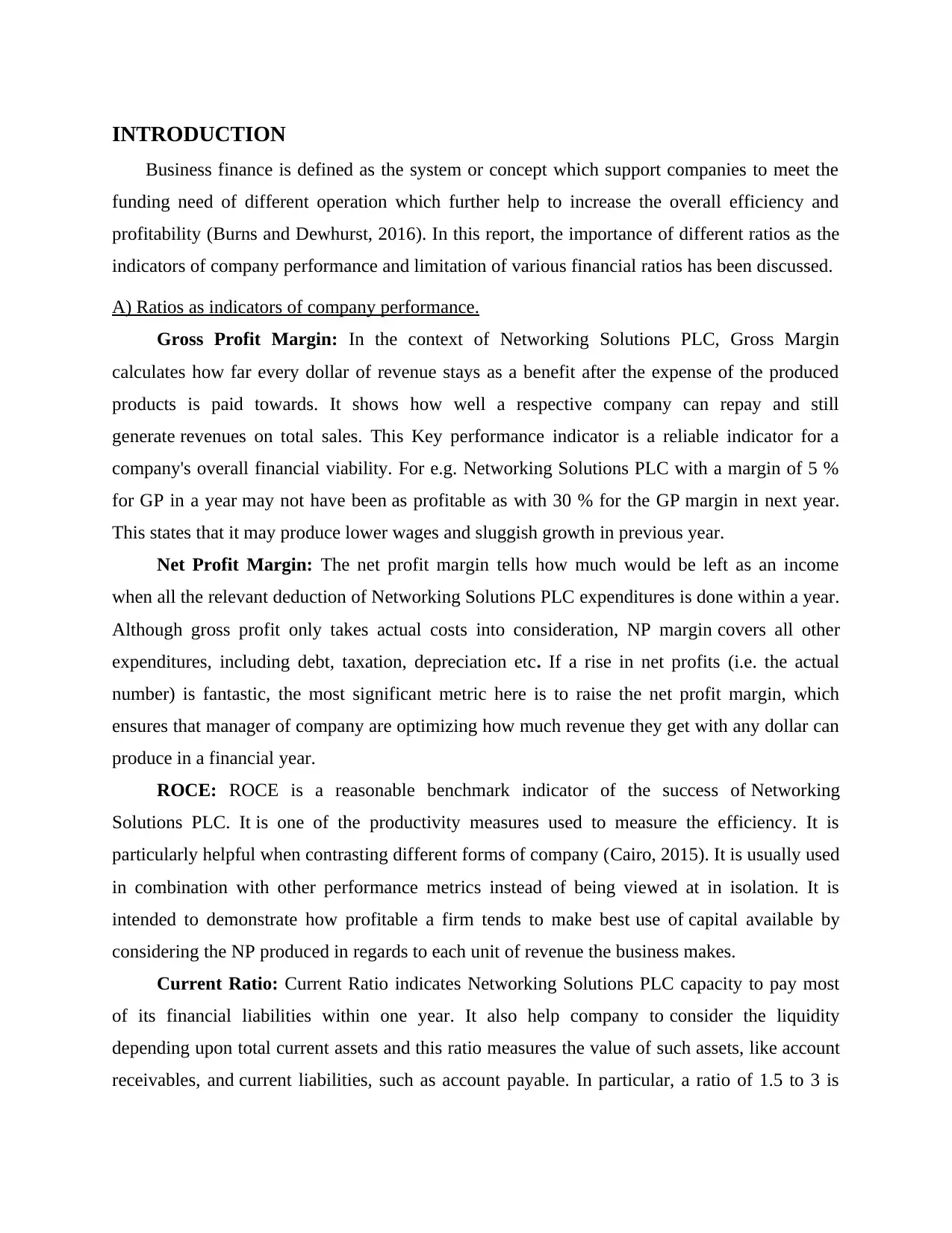
INTRODUCTION
Business finance is defined as the system or concept which support companies to meet the
funding need of different operation which further help to increase the overall efficiency and
profitability (Burns and Dewhurst, 2016). In this report, the importance of different ratios as the
indicators of company performance and limitation of various financial ratios has been discussed.
A) Ratios as indicators of company performance.
Gross Profit Margin: In the context of Networking Solutions PLC, Gross Margin
calculates how far every dollar of revenue stays as a benefit after the expense of the produced
products is paid towards. It shows how well a respective company can repay and still
generate revenues on total sales. This Key performance indicator is a reliable indicator for a
company's overall financial viability. For e.g. Networking Solutions PLC with a margin of 5 %
for GP in a year may not have been as profitable as with 30 % for the GP margin in next year.
This states that it may produce lower wages and sluggish growth in previous year.
Net Profit Margin: The net profit margin tells how much would be left as an income
when all the relevant deduction of Networking Solutions PLC expenditures is done within a year.
Although gross profit only takes actual costs into consideration, NP margin covers all other
expenditures, including debt, taxation, depreciation etc. If a rise in net profits (i.e. the actual
number) is fantastic, the most significant metric here is to raise the net profit margin, which
ensures that manager of company are optimizing how much revenue they get with any dollar can
produce in a financial year.
ROCE: ROCE is a reasonable benchmark indicator of the success of Networking
Solutions PLC. It is one of the productivity measures used to measure the efficiency. It is
particularly helpful when contrasting different forms of company (Cairo, 2015). It is usually used
in combination with other performance metrics instead of being viewed at in isolation. It is
intended to demonstrate how profitable a firm tends to make best use of capital available by
considering the NP produced in regards to each unit of revenue the business makes.
Current Ratio: Current Ratio indicates Networking Solutions PLC capacity to pay most
of its financial liabilities within one year. It also help company to consider the liquidity
depending upon total current assets and this ratio measures the value of such assets, like account
receivables, and current liabilities, such as account payable. In particular, a ratio of 1.5 to 3 is
Business finance is defined as the system or concept which support companies to meet the
funding need of different operation which further help to increase the overall efficiency and
profitability (Burns and Dewhurst, 2016). In this report, the importance of different ratios as the
indicators of company performance and limitation of various financial ratios has been discussed.
A) Ratios as indicators of company performance.
Gross Profit Margin: In the context of Networking Solutions PLC, Gross Margin
calculates how far every dollar of revenue stays as a benefit after the expense of the produced
products is paid towards. It shows how well a respective company can repay and still
generate revenues on total sales. This Key performance indicator is a reliable indicator for a
company's overall financial viability. For e.g. Networking Solutions PLC with a margin of 5 %
for GP in a year may not have been as profitable as with 30 % for the GP margin in next year.
This states that it may produce lower wages and sluggish growth in previous year.
Net Profit Margin: The net profit margin tells how much would be left as an income
when all the relevant deduction of Networking Solutions PLC expenditures is done within a year.
Although gross profit only takes actual costs into consideration, NP margin covers all other
expenditures, including debt, taxation, depreciation etc. If a rise in net profits (i.e. the actual
number) is fantastic, the most significant metric here is to raise the net profit margin, which
ensures that manager of company are optimizing how much revenue they get with any dollar can
produce in a financial year.
ROCE: ROCE is a reasonable benchmark indicator of the success of Networking
Solutions PLC. It is one of the productivity measures used to measure the efficiency. It is
particularly helpful when contrasting different forms of company (Cairo, 2015). It is usually used
in combination with other performance metrics instead of being viewed at in isolation. It is
intended to demonstrate how profitable a firm tends to make best use of capital available by
considering the NP produced in regards to each unit of revenue the business makes.
Current Ratio: Current Ratio indicates Networking Solutions PLC capacity to pay most
of its financial liabilities within one year. It also help company to consider the liquidity
depending upon total current assets and this ratio measures the value of such assets, like account
receivables, and current liabilities, such as account payable. In particular, a ratio of 1.5 to 3 is
⊘ This is a preview!⊘
Do you want full access?
Subscribe today to unlock all pages.

Trusted by 1+ million students worldwide
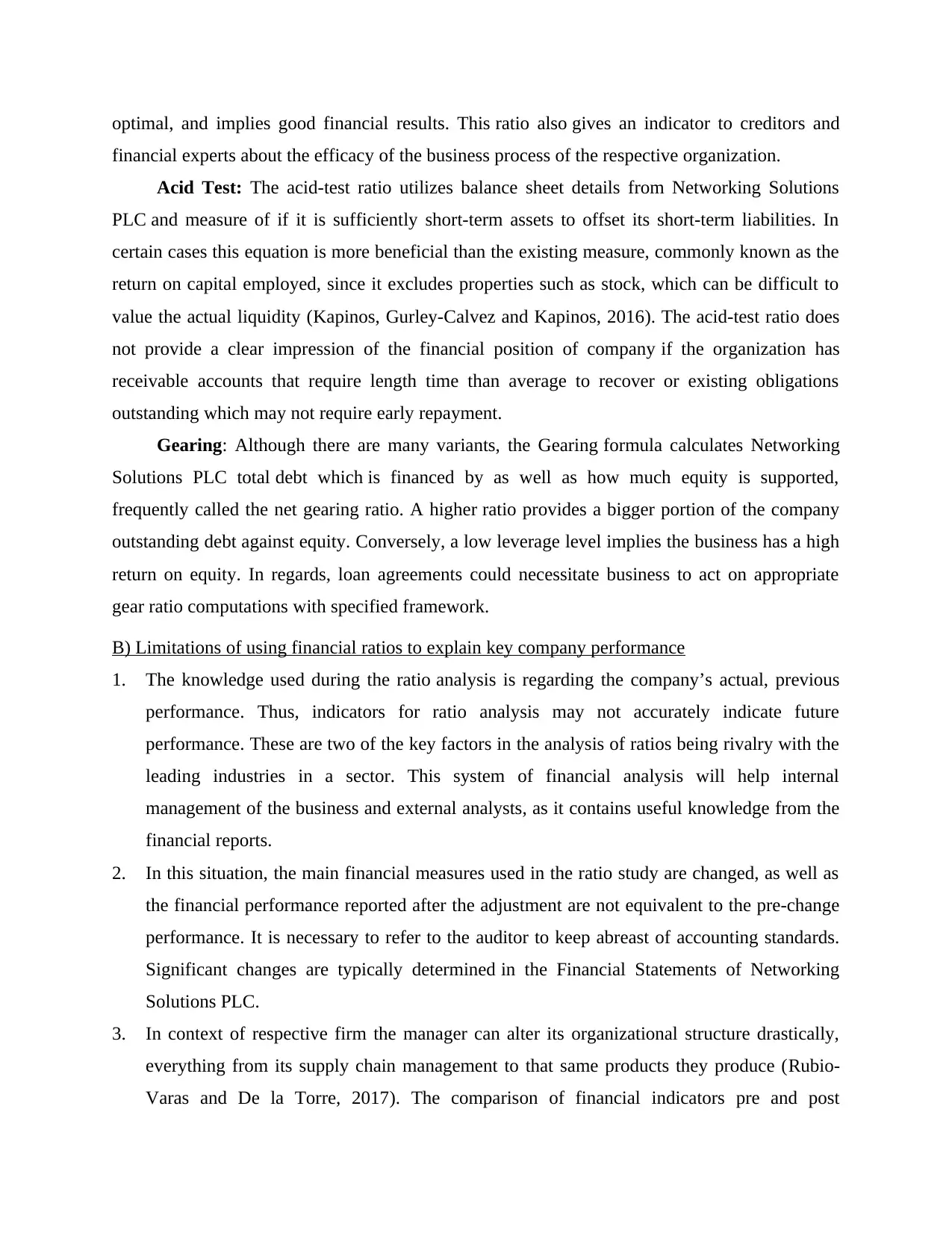
optimal, and implies good financial results. This ratio also gives an indicator to creditors and
financial experts about the efficacy of the business process of the respective organization.
Acid Test: The acid-test ratio utilizes balance sheet details from Networking Solutions
PLC and measure of if it is sufficiently short-term assets to offset its short-term liabilities. In
certain cases this equation is more beneficial than the existing measure, commonly known as the
return on capital employed, since it excludes properties such as stock, which can be difficult to
value the actual liquidity (Kapinos, Gurley-Calvez and Kapinos, 2016). The acid-test ratio does
not provide a clear impression of the financial position of company if the organization has
receivable accounts that require length time than average to recover or existing obligations
outstanding which may not require early repayment.
Gearing: Although there are many variants, the Gearing formula calculates Networking
Solutions PLC total debt which is financed by as well as how much equity is supported,
frequently called the net gearing ratio. A higher ratio provides a bigger portion of the company
outstanding debt against equity. Conversely, a low leverage level implies the business has a high
return on equity. In regards, loan agreements could necessitate business to act on appropriate
gear ratio computations with specified framework.
B) Limitations of using financial ratios to explain key company performance
1. The knowledge used during the ratio analysis is regarding the company’s actual, previous
performance. Thus, indicators for ratio analysis may not accurately indicate future
performance. These are two of the key factors in the analysis of ratios being rivalry with the
leading industries in a sector. This system of financial analysis will help internal
management of the business and external analysts, as it contains useful knowledge from the
financial reports.
2. In this situation, the main financial measures used in the ratio study are changed, as well as
the financial performance reported after the adjustment are not equivalent to the pre-change
performance. It is necessary to refer to the auditor to keep abreast of accounting standards.
Significant changes are typically determined in the Financial Statements of Networking
Solutions PLC.
3. In context of respective firm the manager can alter its organizational structure drastically,
everything from its supply chain management to that same products they produce (Rubio-
Varas and De la Torre, 2017). The comparison of financial indicators pre and post
financial experts about the efficacy of the business process of the respective organization.
Acid Test: The acid-test ratio utilizes balance sheet details from Networking Solutions
PLC and measure of if it is sufficiently short-term assets to offset its short-term liabilities. In
certain cases this equation is more beneficial than the existing measure, commonly known as the
return on capital employed, since it excludes properties such as stock, which can be difficult to
value the actual liquidity (Kapinos, Gurley-Calvez and Kapinos, 2016). The acid-test ratio does
not provide a clear impression of the financial position of company if the organization has
receivable accounts that require length time than average to recover or existing obligations
outstanding which may not require early repayment.
Gearing: Although there are many variants, the Gearing formula calculates Networking
Solutions PLC total debt which is financed by as well as how much equity is supported,
frequently called the net gearing ratio. A higher ratio provides a bigger portion of the company
outstanding debt against equity. Conversely, a low leverage level implies the business has a high
return on equity. In regards, loan agreements could necessitate business to act on appropriate
gear ratio computations with specified framework.
B) Limitations of using financial ratios to explain key company performance
1. The knowledge used during the ratio analysis is regarding the company’s actual, previous
performance. Thus, indicators for ratio analysis may not accurately indicate future
performance. These are two of the key factors in the analysis of ratios being rivalry with the
leading industries in a sector. This system of financial analysis will help internal
management of the business and external analysts, as it contains useful knowledge from the
financial reports.
2. In this situation, the main financial measures used in the ratio study are changed, as well as
the financial performance reported after the adjustment are not equivalent to the pre-change
performance. It is necessary to refer to the auditor to keep abreast of accounting standards.
Significant changes are typically determined in the Financial Statements of Networking
Solutions PLC.
3. In context of respective firm the manager can alter its organizational structure drastically,
everything from its supply chain management to that same products they produce (Rubio-
Varas and De la Torre, 2017). The comparison of financial indicators pre and post
Paraphrase This Document
Need a fresh take? Get an instant paraphrase of this document with our AI Paraphraser
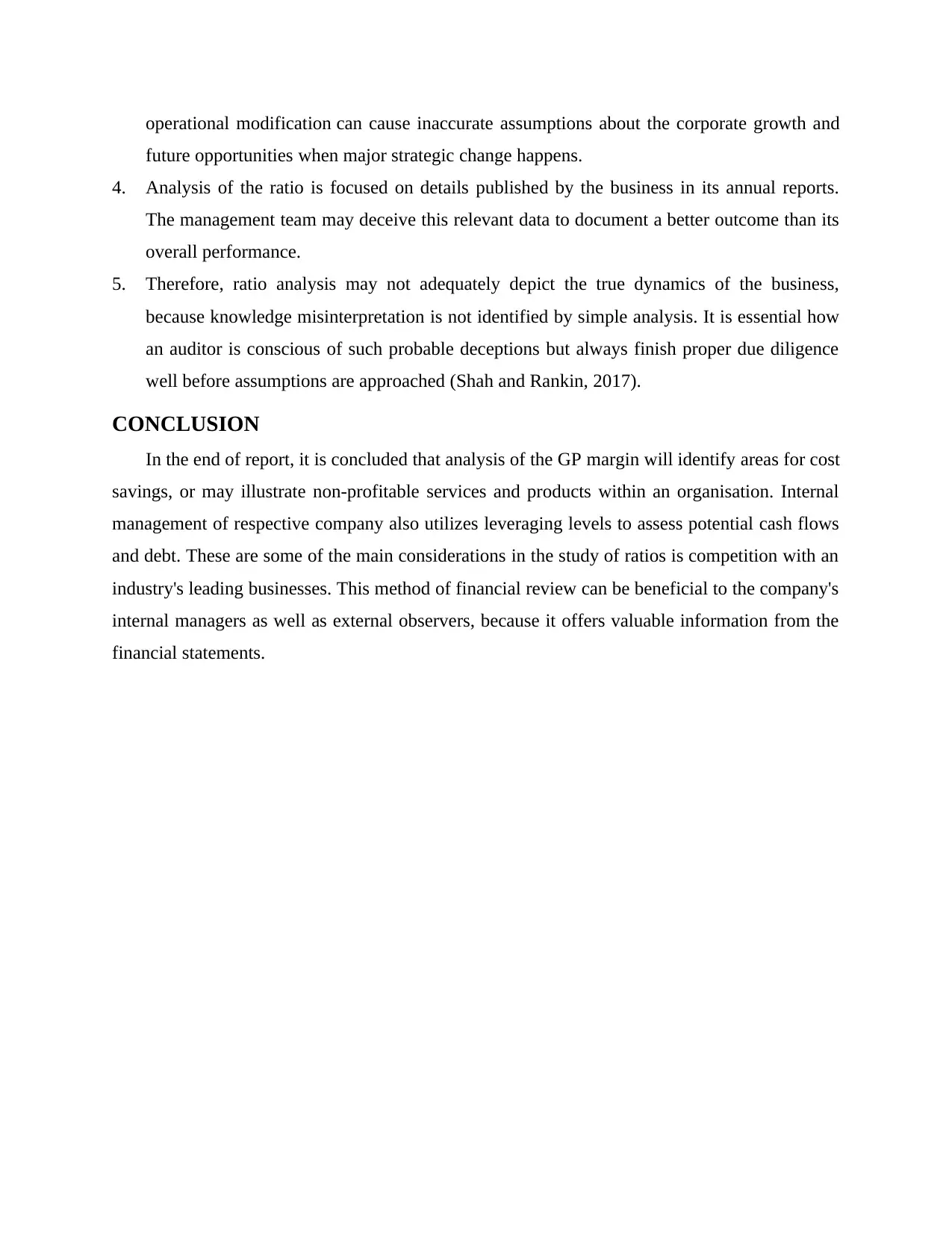
operational modification can cause inaccurate assumptions about the corporate growth and
future opportunities when major strategic change happens.
4. Analysis of the ratio is focused on details published by the business in its annual reports.
The management team may deceive this relevant data to document a better outcome than its
overall performance.
5. Therefore, ratio analysis may not adequately depict the true dynamics of the business,
because knowledge misinterpretation is not identified by simple analysis. It is essential how
an auditor is conscious of such probable deceptions but always finish proper due diligence
well before assumptions are approached (Shah and Rankin, 2017).
CONCLUSION
In the end of report, it is concluded that analysis of the GP margin will identify areas for cost
savings, or may illustrate non-profitable services and products within an organisation. Internal
management of respective company also utilizes leveraging levels to assess potential cash flows
and debt. These are some of the main considerations in the study of ratios is competition with an
industry's leading businesses. This method of financial review can be beneficial to the company's
internal managers as well as external observers, because it offers valuable information from the
financial statements.
future opportunities when major strategic change happens.
4. Analysis of the ratio is focused on details published by the business in its annual reports.
The management team may deceive this relevant data to document a better outcome than its
overall performance.
5. Therefore, ratio analysis may not adequately depict the true dynamics of the business,
because knowledge misinterpretation is not identified by simple analysis. It is essential how
an auditor is conscious of such probable deceptions but always finish proper due diligence
well before assumptions are approached (Shah and Rankin, 2017).
CONCLUSION
In the end of report, it is concluded that analysis of the GP margin will identify areas for cost
savings, or may illustrate non-profitable services and products within an organisation. Internal
management of respective company also utilizes leveraging levels to assess potential cash flows
and debt. These are some of the main considerations in the study of ratios is competition with an
industry's leading businesses. This method of financial review can be beneficial to the company's
internal managers as well as external observers, because it offers valuable information from the
financial statements.
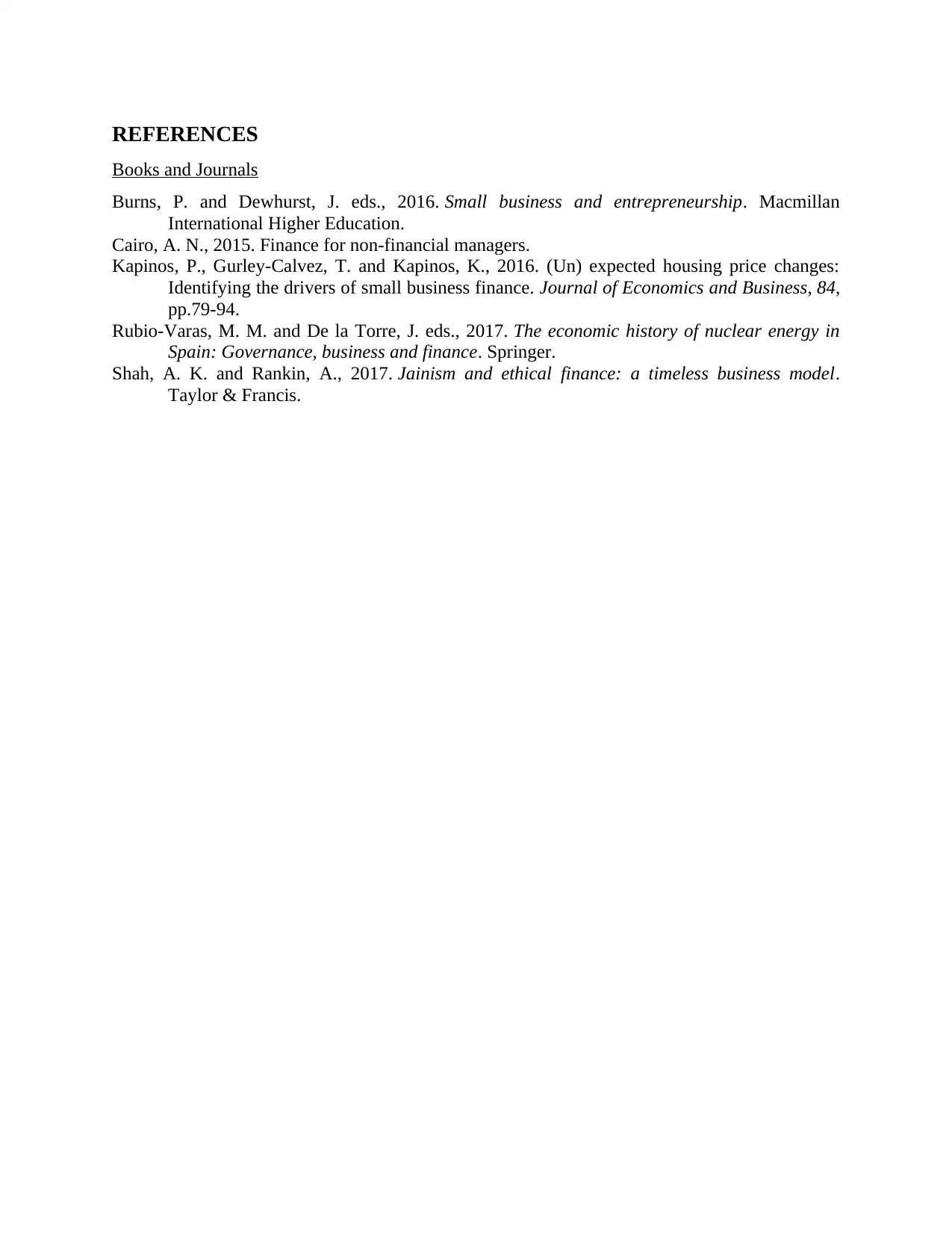
REFERENCES
Books and Journals
Burns, P. and Dewhurst, J. eds., 2016. Small business and entrepreneurship. Macmillan
International Higher Education.
Cairo, A. N., 2015. Finance for non-financial managers.
Kapinos, P., Gurley-Calvez, T. and Kapinos, K., 2016. (Un) expected housing price changes:
Identifying the drivers of small business finance. Journal of Economics and Business, 84,
pp.79-94.
Rubio-Varas, M. M. and De la Torre, J. eds., 2017. The economic history of nuclear energy in
Spain: Governance, business and finance. Springer.
Shah, A. K. and Rankin, A., 2017. Jainism and ethical finance: a timeless business model.
Taylor & Francis.
Books and Journals
Burns, P. and Dewhurst, J. eds., 2016. Small business and entrepreneurship. Macmillan
International Higher Education.
Cairo, A. N., 2015. Finance for non-financial managers.
Kapinos, P., Gurley-Calvez, T. and Kapinos, K., 2016. (Un) expected housing price changes:
Identifying the drivers of small business finance. Journal of Economics and Business, 84,
pp.79-94.
Rubio-Varas, M. M. and De la Torre, J. eds., 2017. The economic history of nuclear energy in
Spain: Governance, business and finance. Springer.
Shah, A. K. and Rankin, A., 2017. Jainism and ethical finance: a timeless business model.
Taylor & Francis.
⊘ This is a preview!⊘
Do you want full access?
Subscribe today to unlock all pages.

Trusted by 1+ million students worldwide
1 out of 6
Related Documents
Your All-in-One AI-Powered Toolkit for Academic Success.
+13062052269
info@desklib.com
Available 24*7 on WhatsApp / Email
![[object Object]](/_next/static/media/star-bottom.7253800d.svg)
Unlock your academic potential
Copyright © 2020–2025 A2Z Services. All Rights Reserved. Developed and managed by ZUCOL.





